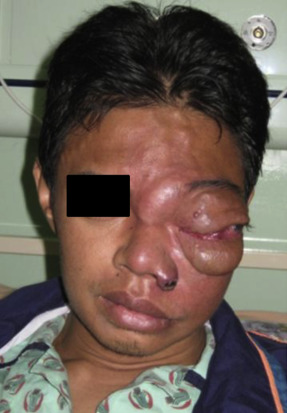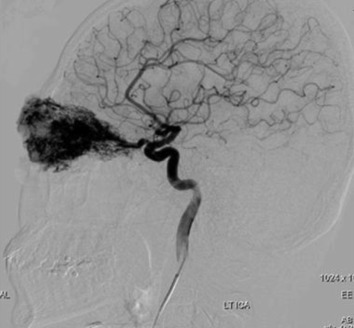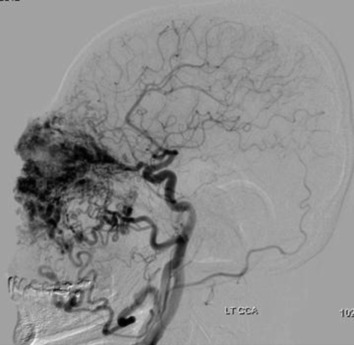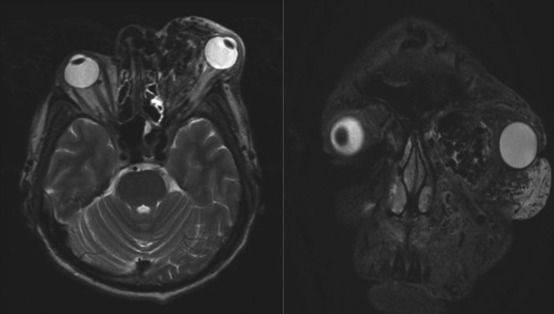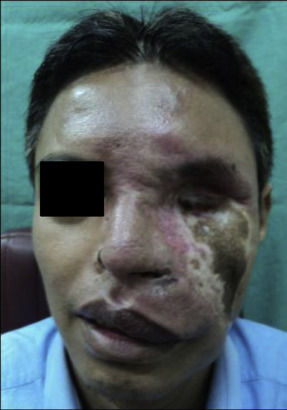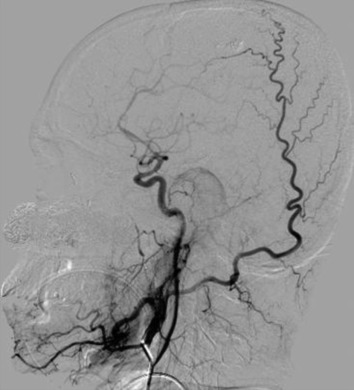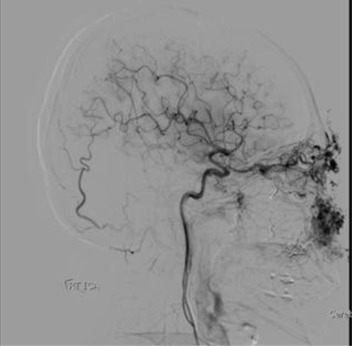Summary
Arteriovenous malformations are congenital lesions that may evolve with time and manifest in a plethora of presentations. They can occur as torrential epistaxis when it extensively involves the facial region. Multi-imaging modalities are available to assist in characterizing the structure of the lesion as well as its location and extent. This complex disease requires a multidisciplinary team approach with preoperative embolization and surgery. We present a rare cause of life-threatening epistaxis in a gentleman with a longstanding orbital and hemifacial arteriovenous malformation and discuss the complexities involved in its management.
Keywords
arteriovenous malformation;epistaxis;hemifacial
1. Introduction
Arteriovenous malformations (AVMs) are a subclassification of vascular malformations proposed by Mulliken and Glowacki in 1982.1 Although vascular malformations are commonly seen in the head and neck region, the incidence of AVMs in the head and neck region is rare in comparison with hemangiomas and venous malformations.2 Intraorbital AVMs usually present with orbital symptoms such as proptosis, diplopia, and facial deformity. Because of its anatomical proximity to the nose, epistaxis may be a presenting feature. The clinical progression of an AVM is scored from I to IV based on its severity using the Schobinger clinical staging.2 We report a case of a stage III rare intraorbital AVM with epistaxis as a presenting feature and its treatment challenges.
2. Case report
A 35-year-old man first presented with a progressive swelling of his left eye lid for 10 years, and was treated then with embolization. His vision at that time was normal. He presented again 5 years later with a large nonpulsatile proptosis and blindness of his left eye, dilated tortuous vessels over the scalp and forehead (Fig. 1), and life-threatening epistaxis requiring repeated nasal packing. An urgent cerebral angiogram revealed an extensive left intraorbital and hemifacial AVM supplied by the ophthalmic, maxillary, facial, lingual, and superficial temporal arteries from both sides (Figs. 2 and 3) with no contrast extravasation noted. Both sphenopalatine arteries were empirically embolized with Histoacryl [n-butyl-2-cyanoacrylate (NBCA)] to prevent further episodes of epistaxis. Magnetic resonance imaging (MRI) showed a heterogeneously enhancing left orbital mass extensively involving the left periorbital and hemifacial area, containing dilated tortuous vessels with a “signal void” ( Fig. 4). A multidisciplinary team decision resulted in preoperative embolization by the interventional radiologist using Onyx 18 (ev3, Irvine, CA, USA), a nonadhesive liquid embolic agent consisting of ethylene vinyl alcohol copolymer dissolved in dimethyl sulfoxide and micronized tantalum powder, via a sonic detachable microcatheter (Balt Extrusion, Montmorency, France), followed by radical surgery the next day.
|
|
|
Figure 1. Large left proptosis with tortuous vessels over the forehead, extending to the nasion and involving the left ala nasi. |
|
|
|
Figure 2. Internal carotid artery run showing arteriovenous malformation feeder vessels from the ophthalmic artery. |
|
|
|
Figure 3. Left common carotid angiogram run shows extracranial arterial feeder of the AVM from the left maxillary and facial arteries branch. |
|
|
|
Figure 4. Magnetic resonance imaging shows a large heterogeneous soft tissue lesion with flow void seen at the periorbital and intraconal parts of the left orbit in keeping with arteriovenous malformation. It is causing displacement of the left globe anterolaterally outside the bony orbit. This arteriovenous malformation extends medially to involve the nasal bridge and superiorly to involve the scalp. |
The Head and Neck team exposed the external and common carotid arteries for immediate access should torrential bleeding occur. The tortuous feeder vessels over the scalp and forehead were ligated via a bicoronal incision approach. The ophthalmic lesion was removed en bloc, resulting in orbital exenteration. The orbital cavity was left to re-epithelialize spontaneously. The excision included the hemifacial AVM involving the left ala nasi, which was reconstructed by the plastic surgery team using a rotational flap, with conchal cartilage for support. Postoperatively, he developed a small area of superficial flap necrosis, which was managed using a full-thickness skin graft, giving good final cosmetic results ( Fig. 5).
|
|
|
Figure 5. Post-left orbital exenteration and ligation of feeder vessels. |
Postoperative angiography showed a small residual AVM arising from the right ophthalmic artery, which was not amenable to embolization due to a risk of blindness (Fig. 6). Histopathological examinations confirmed the diagnosis of an AVM. This patient was also subjected to a trial of Avastin (bevacizumab) weekly for 4 cycles, but it proved futile.
|
|
|
Figure 6. Bulk of the previously large arteriovenous malformation not visible after the surgery. |
One-year follow-up MRI and cerebral angiogram showed residual left facial vascular malformation with multiple feeders from both external and internal carotid artery branches draining into the facial veins (Fig. 7). A 1.5-year postoperative follow-up angiogram revealed a complex left AVM with multiple feeders from both internal carotid arteries, right ophthalmic artery, and both external carotid arteries. Almost 2 years after the operation, the patient presented again with another episode of life-threatening epistaxis, for which an emergency partial maxillary artery embolization was performed using Onyx. The procedure was repeated after 1 week with embolization of both feeders of the maxillary artery without any postprocedural visual defects. Currently, the patient is asymptomatic and on regular follow-up.
|
|
|
Figure 7. One-year follow-up angiogram showing residual arteriovenous malformation. |
3. Discussion
Orbital vascular malformations are rare congenital lesions with numerous, large feeding arteries, a central nidus, and many dilated draining veins.3 Although orbital AVMs are a rare cause of proptosis, it is the most common mode of presentation. Although true orbital AVMs are rare, it must be distinguished from extraorbital AVMs (either an intracranial or maxillofacial arteriovenous shunt) that may produce orbital manifestations.4 ; 5 An interesting variant is the Wyburn–Mason syndrome, which involves the brain, retina, orbit, and face, usually on the ipsilateral side.6 AVMs may present during later life. The reason behind this is attributed to possible stimulation during menarche, pregnancy, or trauma.7
Epistaxis in this case was unique and complex, as the source of bleeding could have been via branches of the maxillary, facial, and both anterior and posterior ethmoidal branches of the ophthalmic arteries bilaterally. Angiography as well as nasal endoscopy showed no gross AVM involvement of the nose, thus leading the team to conclude that the epistaxis was due to an abnormal vessel supply to the nose. Epistaxis occurred when large feeding vessels, particularly from the ophthalmic branches, underwent malformation due to high-pressure angiopathy, causing aneurysmal dilatation and vascular proliferation. This “high pressure angiopathy” causes vessel wall thinning, which weakens the walls, rendering itself at risk of hemorrhage during vessel wall tears. Although initial nasal packing did not help stop the torrential epistaxis, the posterior packing helped prevent aspiration. Histopathologically, AVMs are composed of many microvascular connections between arteries and veins with a nidus of cellular stroma interspersed between the vessels.7
The “great value of orbital angiography” was highlighted by Krayenbuhl in 1962 as a means of investigating unilateral exophthalmos because an orbital angiogram enables identification of the feeders, nidus, as well as drainers of the lesion, thereby differentiating AVMs from other vascular malformations.4 There may be a role for ultrasonography or even MRI5 as a diagnostic tool. Diagnostic AVM features seen on MRI include abnormal vessels with serpiginous aspects as well as “signal void,” because of its high-velocity blood flow.4 Differential diagnosis of such a condition includes arteriovenous fistulas of the orbit and carotid-cavernous sinus fistulas.3
Selective embolization was life-saving whenever this patient experienced life-threatening epistaxis. However, this only provided a temporary window while awaiting definitive surgical intervention. Preoperative embolization occluded the feeding vessels, resulting in a smaller, less vascular mass for excision.4; 8 ; 9 Onyx 18, which was used here, has several theoretically attractive properties. The injection of Onyx is an extremely controlled process (“plug and push” technique) and is not fraught with the art and skill required with the injection of other liquid embolic agents, NBCA in particular. This makes the injection procedure easier and more controllable than an injection with NBCA, which may polymerize quickly and may have a potential risk of gluing the microcatheter in the vessel. Onyx 18 is cohesive but not adhesive: it tends not to break off in pieces and scatter off into the venous system. It can be injected continuously over a long period, and theoretically can close more of the AVM nidus and fistula rather than a proximal occlusion, which is the case with NBCA.10 ; 11
Past authors such as Andracchi et al12 have noted the endovascular contribution in the treatment of such conditions in recent years. Meanwhile, other earlier studies related to AVM treatment have regarded surgical excision of a nidus postembolization as a safe measure of treating a large AVM.13 The management of such an extensive AVM was a challenge, as a complete excision would have resulted in disfigurement, whereas guarded surgical excision will leave tortuous vessels behind with the risk of future hemorrhagic events and the need for surgery again. A decision for definitive surgical intervention with excision of the AVM and orbital exenteration was made to prevent morbidity or mortality from massive hemorrhage. Furthermore, the AVM was progressively increasing in size. If the left eye was functional preoperatively, a transcranial orbitotomy would have been the route of choice in an attempt to expose and resect the AVM, while preserving the function of the eye. The main difficulties in the treatment of such AVMs include complications of endovascular catheterization, namely, vasospasm and embolic phenomena; brisk or even torrential intraoperative bleeding; and postoperative recurrence.9 One drawback of extensive preoperative embolization in our case was the superficial flap necrosis that occurred because its pedicle relied on the transverse facial artery, a branch of the superficial temporal artery.
Lasers, such as the yttrium aluminium garnet (YAG) laser, have played a role in the intraoperative management of similar AVMs, but it was not used in our case because of the extensive nature and bleeding tendency of the AVM.4 Radiosurgery is an alternative choice for cerebral AVMs, but there is no common consensus in terms of its beneficial role in the treatment of an orbital AVM.4 Like most other extensive head and neck tumors, an incomplete or subtotal resection of AVMs may be inevitable but acceptable, as long as the aim of treatment is to reduce postoperative morbidity and provide symptomatic relief.8 Any reconstruction in such patients should allow for future reoperation in the event of recurrent or residual AVMs.8 In an effort to treat this rare but disabling condition, it is important to coordinate efforts between all relevant specialties, in order to produce the best possible results.9
In conclusion, extensive facial AVMs presenting with life-threatening epistaxis is rare and poses a challenge in its acute as well as long-term management, which could lead to loss of function and disfigurement. The definitive treatment for such an extensive lesion is embolization to control bleeding and surgery wherein a near-complete excision is acceptable to preserve function and cosmesis.
References
- 1 J.B. Mulliken, J. Glowacki; Hemangiomas and vascular malformations in infants and children: a classification based on endothelial characteristics; Plast Reconstr Surg, 69 (1982), pp. 412–422
- 2 M.C. Garzone, J.T. Huang, O. Enjolras, I.J. Frieden; Vascular malformations: Part 1; J Am Acad Dermatol, 56 (2007), pp. 357–370
- 3 J. Hamada, M. Morioka, Y. Kai, T. Sakurama, J. Kuratsu; Spontaneous arteriovenous fistula of the orbit; Surg Neurol, 65 (2006), pp. 55–57
- 4 P.D. Hieu, G. Besson, S. Roncin, M. Nonent; Successful surgical treatment of intraorbital arteriovenous malformation; Neurosurgery, 40 (1997), pp. 626–631
- 5 R. Huna-Baron, A. Setton, M.J. Kupersmith, A. Berensei; Orbital Arteriovenous malformation mimicking cavernous sinus dural arteriovenous malformation; Br J Opthalmol, 84 (2000), pp. 771–774
- 6 T. Matsuo, H. Yanai, K. Sugiu, S. Tominaga, Y. Kimata; Orbital exenteration after transarterial embolization in a patient with Wyburn–Mason syndrome: pathological findings; Jpn J Opthalmol, 52 (2008), pp. 308–313
- 7 M. Moin, R.C. Kersten, F. Bernardini, et al.; Spontaneous haemorrhage in an intraorbital arteriovenous malformation; Opthalmology, 107 (2000), pp. 2215–2219
- 8 Y. Kaufman, P. Cole, R. Dauser, L. Hollier Jr; Intraorbital arteriovenous malformation; J Craniofac Surg, 18 (2007), pp. 1091–1094
- 9 R. Trombly, D.I. Sandberg, S.A. Wolfe, J. Ragheb; High-flow orbital arteriovenous malformation in a child: current management and options; J Craniofac Surg, 17 (2006), pp. 779–782
- 10 W. Weber, B. Kis, R. Siekmann, D. Kuehne; Endovascular treatment of intracranial arteriovenous malformations with Onyx: technical aspects; Am J Neuroradiol, 28 (2007), pp. 371–377
- 11 C. Cognard, A.C. Januel, N.A. Silva Jr, P. Tall; Endovascular treatment of intracranial dural arteriovenous fistulas with cortical venous drainage: new management using Onyx; Am J Neuroradiol, 29 (2008), pp. 235–241
- 12 S. Andracchi, M.J. Kupersmith, P.K. Nelson, J.S. Slakter, A. Setton, A. Berenstein; Visual loss from arterial steal in patients with maxillofacial arteriovenous malformation; Ophthalmology, 107 (2000), pp. 730–736
- 13 H. Nagashima, H. Okudera, S. Muraoka, K. Hongo, S. Kobayashi; Strategic embolisation for successful resection of a large cerebral arteriovenous malformation; J Clin Neurosci, 7 (2000), pp. 86–87
Document information
Published on 26/05/17
Submitted on 26/05/17
Licence: Other
Share this document
Keywords
claim authorship
Are you one of the authors of this document?
